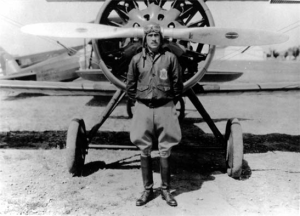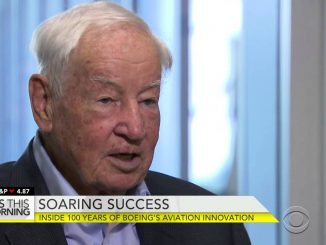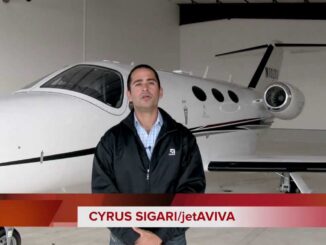Tinker epitomized Native American strength,
leadership
By Randy Roughton, Air Force News Service / Published November 21, 2013
PAWHUSKA, Okla. (AFNS) —
The nation’s highest-ranking Native American general didn’t have to be on the ill-fated mission in the Pacific that took his life in 1942. The question of why he was always intrigued Dr. James L. Crowder, a historian and author of “Osage General: Maj. Gen. Clarence L. Tinker.”
Maj. Gen. Clarence L. Tinker was a natural leader who personally led his airmen into combat missions during the early days of World War II. He perished, along with his crew, during the battle of Midway. (U.S. Air Force photo/Courtesy)
So he once asked the question while talking to members of the Osage Nation in Oklahoma.
“We were having a meeting about Osages who served in the military, and I asked them, ‘Why would he do that?’” Crowder said. “All of the key documents from that time showed he didn’t have to be on that mission. They said an Osage leader is never at the back of his band of warriors.”
Tinker, a one-eighth Osage, grew up on the reservation in Pawhuska, Okla. George Edward Tinker, his father, started Osage County’s first newspaper, the Wah-Sha-She News. Even after Tinker became a general, he sometimes called home to talk to his father, just so he could hear his native language.
“So General Tinker was always proud of his Indian heritage,” Crowder said. “In 1906, when they turned the tribe lands into individual holdings after oil was discovered in the Osage Nation, the Osage became the richest tribe in American history. As an alumni member at 19 years of age, General Tinker became quite well-to-do and had a lot more money than many of the officers he served with. He was not one to show off his wealth, although he did like to show off. He was known for coming in the MacDill (Air Force Base, Fla.) officer’s club on a mule with full Indian headdress for the Army-Navy football game. He liked to be the center of attention, yet he was kind of a quiet person, too.”
Crowder describes the general as 5-foot-10 and 150 pounds, with extremely long sideburns he was always proud of.”(Gen. Henry H.) Hap Arnold told him several times, ‘Get those sideburns shaved,’” Crowder said. “He would, as long as Hap Arnold was around. But then he would just grow them back out.”
Early in his military career, Tinker served with the 25th Infantry Division, originally in Spokane, Wash., and later moved with the division to Hawaii. In 1919, Tinker took an interest in flying, earned his pilot’s license and entered the Army Air Service in 1922. Five years later, he was named the commandant of the Air Service Advanced Flying School at Kelly Field in San Antonio, and later commanded several pursuit and bomber units. In 1940, he pinned on his first star, and, after Pearl Harbor, was named commander of the Army Air Corps’ Hawaiian Air Force, which became the 7th Air Force in February 1942, with Tinker as its first commander. He was promoted to major general a month earlier, just six months before he disappeared over the Pacific. In its announcement of Tinker’s appointment as Hawaiian Air Force commander, Time magazine described Tinker as “a spit-and-polish, sky-ripping flight officer part Osage Indian, flyer since 1920.”
When Tinker assumed command of the Hawaiian Air Force, his father reassured friends in the corner drugstore in Pawhuska, “You can go home and sleep peacefully now. The Tinkers have got the situation well in hand,” he said, according to an article in The Milwaukee Journal on Feb. 14, 1942.
Before Dec. 7, 1941, Tinker warned that the Japanese were the biggest threat instead of Germany, and he thought the Air Force would be the major factor during World War II. He also believed that a long-range attack against Japan would be the key to war in the Pacific. During the spring of 1942, he considered the Japanese on Wake Island as a threat to Midway and Pearl Harbor. However, he didn’t think the B-17 Flying Fortress could make the 1,300-mile trip so he acquired four Consolidated LB-30 Liberators and prepared for an attack on Japanese forces on the island, Crowder said. Tinker, then commander of the ArmyAir Forces Hawaiian Department, died with eight crewmembers when their B-24 Liberator disappeared through a formation of clouds over the Pacific Ocean during a long-range mission on Wake Island that he chose to personally lead. He was the first American Army general officer killed in combat during World War II. Oklahoma City Air Depot, the base that had only recently opened, was renamed Tinker Air Force Base.
“His career stretched from the beginning of the Air Force as we know it into World War II,” Crowder said. “He came through that period in the 1930s when the Army Air Corps wasn’t really held in great respect and was very poorly funded. Yet he came through it, and I think he was a very natural pilot.
“The fact that he gave his life in such a dramatic way as commander of the 7th Air Force leading his men, is also important in remembering General Tinker.
“But General Tinker’s favorite thing was working with young Airmen. He thought the key was the young men coming up in the military, and he always tried to give them positive experiences with officers. He was an encourager is a way anybody could remember him.”
Images and items of Tinker and his career can still be found throughout the base that was named for him more than seven decades since he disappeared over the Pacific. There’s a bust of Tinker in the Air Force Sustainment Center Headquarters, and a painting and a display of his awards and medals greet visitors to the Tinker Club.
But the first seeds of his leadership skills were planted in Tinker’s Osage childhood. His portrait hangs in the chiefs room of the Osage Tribal Museum in Pawhuska, and to this day, the Osage Nation honors him with a song and dance on the final day of their four-day In-lon-shka. The annual celebration emphasizes the culture and values that date back to the 1880s after they moved to their current reservation in Oklahoma. The Tinker family attends each year, with most of the men participating in the dancing.
“We have veteran dances that honor our soldiers,” said Chief John D. Red Eagle, principal chief of the Osage Nation. “My father was a World War II veteran, and we honor him during that time, as our other families honor their soldiers. We talk about when they were in the war because they were very proud to be a part of the military. That’s the way they felt about General Tinker because of his service to the United States as a soldier. It is a big honor to have a song in that dance.”




